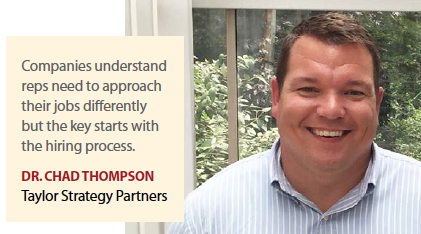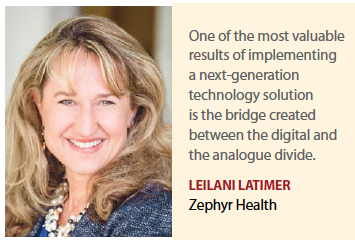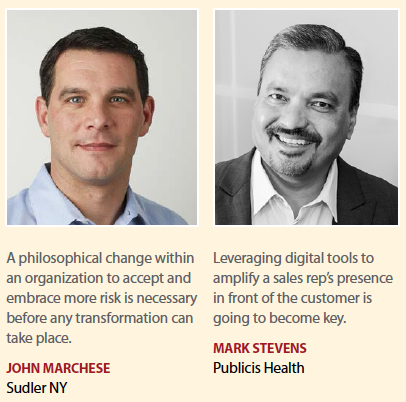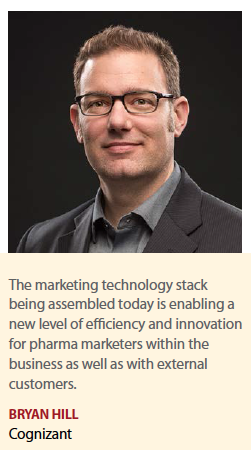The implementation of digital technologies will have a great impact on the way pharma marketers engage with both patients and healthcare professionals. The impact will be in terms of amplified time and efficiency, much better sales and marketing alignment, the ability to customize by audience, and of course deep, directional analytics.
“To be more specific, implementation of these digital technologies will mean eliminating repetitive tasks for marketers so they can focus on bigger ideas, more meaningful emails, better targeting, reduction of human error, robust data-driven lead development, multichannel marketing excellence, and truly differentiated marketing experiences," says Heather Aton, practice lead, customer innovation and planning, of Elevate Healthcare.
 With fully integrated systems, enhanced with big data integration, sales and marketing teams will have a detailed view of the customer that includes a historic view as well as a predictive view, so they will be able to see not just what interactions the customer has had but have insight into what the recommended interactions and actions for the sales and marketing team in the future, e.g. webinars and online materials or an in-person visit, says Leilani Latimer, senior director, global marketing, Zephyr Health.
With fully integrated systems, enhanced with big data integration, sales and marketing teams will have a detailed view of the customer that includes a historic view as well as a predictive view, so they will be able to see not just what interactions the customer has had but have insight into what the recommended interactions and actions for the sales and marketing team in the future, e.g. webinars and online materials or an in-person visit, says Leilani Latimer, senior director, global marketing, Zephyr Health.
Experts suggest that the commercial model as most pharma marketing and sales staff know it today — the one-way push of product and messages — is fast losing its effectiveness, and a commercial transformation brought on by digital tools is on the horizon.
“In the past, commercializing a product meant pushing it out to the masses," says John Marchese, executive VP, managing director, Sudler NY. “But healthcare is no longer in that space."
Instead, the industry must focus on listening and servicing all its stakeholders as customers. “Having a true customer mindset toward all stakeholders and servicing those customers is the biggest commercial shift about to happen," he says.
A Glimpse Into the Future
Experts say developing a market-leading commercial model requires true organizational change. Furthermore, companies need to focus their energies on streamlining the marketing and sales processes — just as they have for their manufacturing needs — to be competitive for the long term.
 Take for instance blockchain, the public, distributed ledger protocol that allows for the recording of transactions or transfer of value, such as Bitcoin. Blockchain is accessible to all computers running the same protocol. Developed initially for use in the financial sector, it may have many implications for pharma. Although the industry is focusing first on using this next-generation technology in drug development, it could also have commercial applications, especially in patient adherence measures.
Take for instance blockchain, the public, distributed ledger protocol that allows for the recording of transactions or transfer of value, such as Bitcoin. Blockchain is accessible to all computers running the same protocol. Developed initially for use in the financial sector, it may have many implications for pharma. Although the industry is focusing first on using this next-generation technology in drug development, it could also have commercial applications, especially in patient adherence measures.
Blockchain is decentralized, which means its extreme divisibility and its ability to verify transactions without third parties makes engaging in exchanges of digital assets nearly as simple as tweeting or texting.
Early this year, at a working group for the Hyperledger Blockchain Project — a collaborative effort to advance blockchain technology across all industries — consulting firm Accenture discussed the possibility of using the technology to thwart counterfeit drugs. Accenture proposed its use for more efficient tracking of medicines using immutable data, thus improving accountability in the pharmaceutical industry. Accenture has launched a specialized practice within its financial services group to help institutions implement blockchain technology and is looking to include other industries that will benefit, such as healthcare.
Another initiative, the BlockRx Project — a collaborative group of pharma professionals, blockchain experts, and regulatory advisors — aims to verify and enhance the integrity of a drug supply chain and accelerate new drug development by leveraging the blockchain to support and manage the drug development lifecycle. The BlockRx Project will be the first global pharma initiative to use blockchain as the model for all future drug development, manufacturing, and distribution.
According to the BlockRx Project website, Advanced Digital Ledger Technology (ADLT) can serve as a bridge between a patient adherence program, a patient incentive program, and the relevant patient data required to help improve care. While keeping in mind HIPAA requirements, this task can be accomplished in a blinded way through the assignment of patients with digital IDs and giving the patient the ability to control how much of his or her personal health record and crucial baseline data such as age, gender, and race are revealed.
 By leveraging the Internet of Medical Things (IoMT) and ADLT, biopharmaceutical companies will have the ability to facilitate bilateral communications and manage incentive programs, gather patient level data that will impact adherence, decrease healthcare costs, and provide new insights into existing therapies while potentially identifying new therapeutic niches.
By leveraging the Internet of Medical Things (IoMT) and ADLT, biopharmaceutical companies will have the ability to facilitate bilateral communications and manage incentive programs, gather patient level data that will impact adherence, decrease healthcare costs, and provide new insights into existing therapies while potentially identifying new therapeutic niches.
According to Mark Stevens, chief commercial officer, Publicis Health, upcoming technologies that include IoT (Internet of Things) and IoNT (Internet of Nano Things) and blockchain will require the healthcare industry to fundamentally change how it discovers and patents new products and how it identifies patients and measures outcomes.
“Right now this technology is at the experimental stages, mostly around financial transactions, but when done right, it has the potential to eliminate the middlemen or redefine their role," Mr. Stevens says. “Blockchain could revolutionize healthcare, maybe five to 10 years from now."
Even the U.S. Department of Health and Human Services is investigating the opportunities for blockchain within the healthcare industry.
Earlier this summer, HHS called for white papers on how blockchain technology can be used within the healthcare industry in a contest. This is the government’s first initiative for the technology, and the winners will present their work at a Blockchain and Healthcare Workshop co-hosted by the department’s Office of the National Coordinator for Health Information Technology and the National Institute of Standards and Technology.
Blockchain may be the cool tool of tomorrow, but there are plenty of other options that are available today that can provide solutions to speed a drug to market and help streamline commercialization efforts. Automation platforms and technologies are providing the ability to target and communicate with a laser focus, as well as make adjustments in near real time during the commercialization process. Cloud solutions, marketing automation software, content management platforms, and digital sales tools are also gaining traction, and there is more room for growth.
Pharma companies and marketing organizations, especially progressive agencies and consultants, are definitely taking advantage of marketing automation and cloud solutions to drive internal collaboration, efficiency, and integration, Ms. Aton says.
 From using marketing automation to address administrative needs such as procurement to having greater capacity to aggregate data to push forward new medicines and services, manufacturers are making technology transitions for infrastructure needs.
From using marketing automation to address administrative needs such as procurement to having greater capacity to aggregate data to push forward new medicines and services, manufacturers are making technology transitions for infrastructure needs.
“However, in their marketing efforts, pharma companies are still experiencing a lot of digital transformation and greater change is still required to truly deliver on all the possibilities for technology," Ms. Aton says. “Pharma marketers must accept and enable this change. They will need to challenge barriers, explore nontraditional capabilities, and pursue new operating models to drive solutions."
According to Bryan Hill, chief technology officer-life sciences at Cognizant, marketing automation platforms such as Marketo easily plug in to digital assets like websites to enable dynamic content experiences as well as connect to CRM systems, eliminating manual processes to publish content and consolidate data. In terms of accelerating transformation, provisioning cloud environments and services through intuitive user interfaces significantly reduces the complexity of initiating or scaling services as well as the time required to implement new campaigns, he says.
Also, cloud solutions that centralize training, resources, and scheduling can completely transform the speaker bureau experience by enabling an on-demand training solution that a speaker may complete on his smartphone or provide easy event scheduling for reps. Virtual, augmented, or mixed reality experiences offer an opportunity to provide accelerated learning environments through rich, contextual, interactive content at conferences and events.
“Powered by the cloud, ecosystems, and open standards, the marketing technology stack being assembled today is enabling a new level of efficiency and innovation for the pharma marketer within the business as well as with external customers," Mr. Hill says.
Leveraging the capabilities of digital tools helps the industry transition from analogue systems to digital ones, Ms. Latimer says.
“One of the most valuable results of implementing a next-generation technology solution is the bridge created between the digital and the analogue divide," she says. “The sales world — whether in pharma or other industries — is still very much an analogue world, with pre-built relationships being the primary success factor. Today, sales and marketing teams must digitize those relationships for improved customer engagement and of course to get greater customer insight to drive loyalty. The teams that will be the most successful will be those that create deep integration between their data — customer, market, internal, and external data sources — and their systems."
And the sooner the transition, the better, Mr. Stevens says, as sales reps are getting less and less time in front of the physician, so they need to start cultivating relationships through digital means instead calling for a more “orchestrated" engagement with the customer.
“The current calling pattern of a sales rep, reveals that one in every five calls is replaced by a digital interaction with the physician, which means at the going rate, 20% of annual personal interactions could be replaced via digital means," he says. “The personal interaction we’ve come to rely on in the past is either dead or slowly dying."
Leveraging digital tools to amplify the sales rep’s presence in front of the customer is going to become key. For example, five years ago it was impossible for a rep to know how many type 2 diabetes patients may be considering switching from oral to insulin injectable. However, today, with a click of a button, that information is available.
 “This information becomes a lot more meaningful to the physician who’s involved in the outcome of that particular patient," Mr. Stevens says. “If a rep can say: ‘I can help save you 10% off your total expenses and at the same time improve the outcomes of the health of your population,’ this is extremely powerful. Five years ago, the conversation might have been: ‘Doctor, can you put your next 10 patients on my drug?’ This type of conversation is not going to resonate today.
“This information becomes a lot more meaningful to the physician who’s involved in the outcome of that particular patient," Mr. Stevens says. “If a rep can say: ‘I can help save you 10% off your total expenses and at the same time improve the outcomes of the health of your population,’ this is extremely powerful. Five years ago, the conversation might have been: ‘Doctor, can you put your next 10 patients on my drug?’ This type of conversation is not going to resonate today.
“So the role of commercial is going to be extremely orchestrated between electronic health records, between medical inquiries through Medscape, through WebMD, and making that very valuable interaction a lot more meaningful in front of the customer," he continues. “This is all going to happen only with the digitizing of health records and communication."
Digital transformation will also enable the industry to provide customized services around products that are much more relevant and personalized to the individual.
“That’s the promise of digital transformation that has a lot of appeal, and we think that’s what the future will be," Mr. Marchese says. “This might include adjusting creative and putting a different emphasis on the messaging that goes to a particular person based on what is understood about his or her current needs."
Overcoming the Status Quo
The challenges to commercial transformation are many, but none matter until the fear of change is conquered.
“Before even getting into all the new technology, a philosophical change within an organization to accepting and embracing a bit more risk is necessary before any transformation can take place," Mr. Marchese says. “In an environment that’s typically been risk averse, leaders have to not only accept some risk, but embrace it and learn from both successes and failures."
Ms. Aton agrees that the biggest challenge for client organizations is getting out of the mentality of being comfortable with the way things have always been done.
“This mindset breeds resistance to iterative lessons and improvements, and ultimately to innovative solutions," she says, and rather than being safe, it is actually dangerous to commercial success today. “Not only does this sentiment shut down the aspiration to strive for better, but it spreads distrust and is a barrier to progress and excellence."
A more progressive mindset would also enable products to get to market faster, as market research can be done in real-time during the campaign, instead of requiring months and months of testing ahead of launch. The ability to measure a campaign’s lifecycle earlier is enabled by evaluating more granular dimensions, such as specific digital publishers, creative versions or ad placements, enabling ongoing optimization that drives ROI.
“One of the more tactical shifts enabled by digital transformation is moving from doing all market research to test an idea on the front end to testing the idea in the market and tweaking it over time, similar to the data-driven creative concept," Mr. Marchese says. “Today, when building a campaign, it’s put into market research 10 times over to make sure it’s the right idea, versus maybe testing it once, putting it into the market, and having the back end analytics tell us how the campaign is performing, and then optimize for that feedback."
There are other challenges beyond the debilitating effect of a risk-averse attitude. The growth of new disciplines has created a partnership landscape that is more extensive and disjointed and the need for integration is greater than ever before.
“The clash of the digital natives and traditionalists has only expanded — precisely when more trust is needed," Ms. Aton says. “What used to be considered new areas of expertise have grown familiar in today’s lexicon, and the fragmentation of expertise has really torn apart the integration it takes to build a brand well. There are more offerings and a greater number of entities vying for direct access to marketing decision makers."
At best, automation and the broader digital spectrum should enable a meaningful experience at every touchpoint — one that both provides value to the customer as well as informs the next message or action from the brand, Mr. Hill says. However, there is also a risk that these technologies could provide a robo-experience that delivers more of a scripted monologue vs. a dialogue and is unable to adapt to changing customer preference, behavior, or situation.
The key to maximizing this connected technology backbone for pharma is to engage patients and healthcare professionals within their digital flow.
“Connecting with patients or HCPs in this manner means doing so on their terms within their real-world digital environment," Mr. Hill says.
“For example, does the content on a consumer website adapt to a user’s search behavior or website navigation patterns to suggest relevant content and resources, similar to an Amazon.com experience? At the end of the day, well executed digital programs delivered in a familiar and timely manner enable a valued exchange with customers rather than noise and frustrating interruptions."
Due to a shortage of qualified candidates in the workforce, another difficult issue is hiring the correct talent or finding qualified partners to handle new responsibilities from the digital transformation. Mr. Hill notes that recent job postings for Adobe talent, for example, showed more than 5,000 open positions.
“A key challenge for businesses is accessing the skills to not only manage the technology, but also understand the complexities of these platforms well enough to design programs that best leverage the capabilities to deliver on a campaign mission," Mr. Hill says.
Digital technologies can also greatly enhance the sales rep role, if companies hire the right skill sets to be able to take advantage of the new processes.
“Companies understand reps need to approach their jobs differently," says Chad Thompson, Ph.D., VP, consulting and assessment, at Taylor Strategy Partners. “Where the rubber hits the road, however, is in the hiring process."
In other words, changes in perspective among commercial leadership do not necessarily lead to changes in how reps are hired. It is difficult to expect hiring managers to make different decisions using the same tools and approaches that have been in place for years.
“We have found that a careful definition of the behaviors reps are expected to demonstrate and not demonstrate is the right first step," Mr. Thompson says.
These behaviors are different from salesforce to salesforce. A one-size-fits-all approach simply does not allow for all the relevant nuances. For instance, rep expectations should differ if a drug is first to market vs. being fourth; or if the goal is focused on expanding market share or taking market share; or selling to a general practitioner versus an oncologist.
“Once these key behaviors have been identified, customized pre-hire assessment processes can be developed to measure how likely a candidate is to demonstrate those behaviors," Dr. Thompson says. “When combined with targeted recruiting efforts designed to get candidates with the right backgrounds into the process, companies can accelerate sales performance and reduce costly turnover."
Last but certainly not least, another challenge lies in integrating regulatory and compliance with marketing automation programs. If automation enables a near-real time dialogue with a brand’s audience, the business must prepare and provide approvals for messaging and content somehow.
“From consult to approval loops, businesses may need to rethink tools and procedures used to manage these processes as well as perhaps resetting the bar for risk tolerance in an environment wrought with inherent variability," Mr. Hill says. (PV)



















